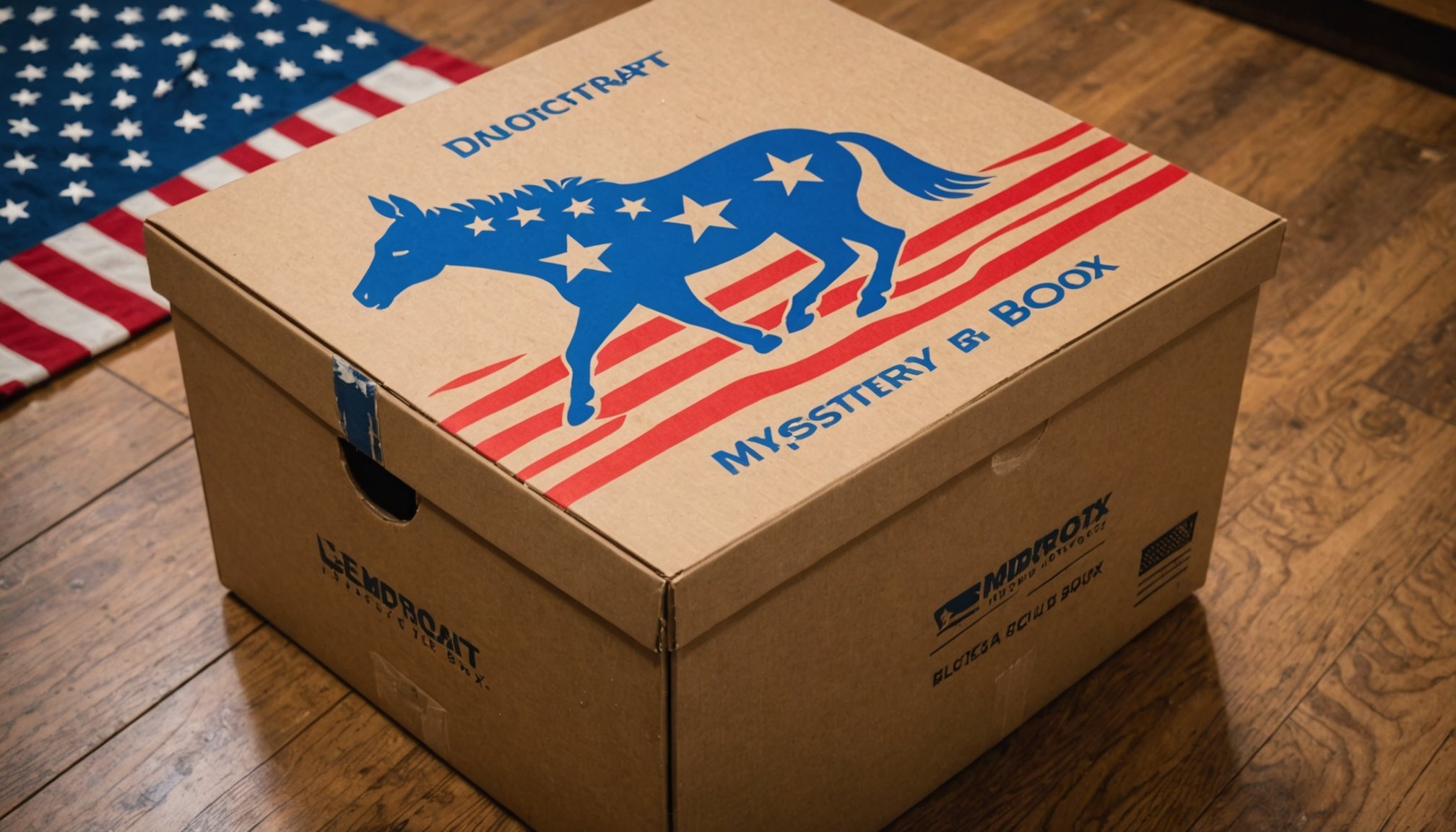The “Democrat Mystery Box” encapsulates the layered complexities of political strategies within the Democratic Party. This concept reveals not just the intricacies of policy-making but also the controversies and criticisms surrounding influential figures. By dissecting historical contexts and current narratives, we uncover how this box reflects the evolving identity of the party. Join us as we decode the secrets within and explore the implications for America’s political landscape.
Understanding the Democrat Mystery Box Concept
In the realm of political discourse, few phrases generate as much curiosity as the “Democrat Mystery Box.” This concept isn’t just a catchy term; it encapsulates the multifaceted and often intricate nature of the Democratic Party’s policies. Delving into the “mystery box” serves to uncover the layers of complexity and hidden agendas within the party, which sometimes elude the public eye.
Also read : Unlock excitement: discover the ultimate case opening hub
Central to the Democrat Mystery Box is the notion of unraveling the complexities of the Democrat agenda. The Democratic Party has a rich history marked by shifts in ideology and policy that can often appear opaque to outsiders. These hidden policies are a significant point of intrigue and speculation, as they suggest strategies and platforms that may not be immediately visible. A careful analysis reveals that these policies are often a response to societal demands, meant to address issues like economic inequality, healthcare, and social justice. However, critics frequently argue that these intentions are not always aligned with the outcomes.
Another important facet of this concept is the role of political intrigue in the Democrat party. This intrigue stems from the party’s attempts to balance progressive ideals with pragmatic governance, often resulting in internal debates and differing opinions on how best to address pressing issues. Understanding these dynamics involves peeling back layers of public statements and press releases to identify the underlying strategies that drive the party’s decisions.
Topic to read : Unlocking Energy Savings: How Smart Home Devices Revolutionize Energy Management
Transparency remains a key issue in deconstructing the Democrat Mystery Box. While the party publicly champions transparency in politics, critics point to instances where actions might contradict these intentions. Emphasizing transparency involves critically examining how decisions are made, how key figures within the party influence policies, and the extent to which the public is informed about these processes.
Additionally, the exploration of this mystery box involves analyzing Democrat party decisions, which can provide insights into the party’s ideology and electoral strategies. For example, understanding the motivations behind major legislative proposals lets us glimpse the broader vision that party leaders hold for the country. Moreover, such scrutiny can illuminate the shifting priorities and adaptations that occur as the party navigates changing political landscapes.
An interesting angle to consider is how media narratives and public perception play into the Mystique of the Democrat Mystery Box. The influence of media on the Democrat party often sways public sentiment, impacting everything from electoral outcomes to policy support. By studying these narratives, one can better comprehend how the party’s image is crafted and perceived, both positively and negatively.
Finally, a pivotal piece to this puzzle lies in observing the internal and external challenges facing the Democrat party. Understanding these challenges calls for looking beyond the surface-level perceptions to examine the interactions and coalitions within the party. This includes noting differences within the Democrat party that may arise between progressive and moderate wings, as well as the external pressures from opposition parties and grassroots movements. Recognizing these dynamics is crucial for comprehending the broader implications of the party’s strategies and decisions.
The Democrat Mystery Box, therefore, serves as a metaphor for a deeper dive into understanding the Democratic Party’s nuanced realities. By engaging with the idea of the “mystery box,” interested parties are encouraged to look beyond political rhetoric, examining the interplay of transparency, hidden agendas, and the complexities of party dynamics. For those eager to explore these intriguing facets further, http://democratmysterybox.com offers a platform that caters not just to enthusiasts but also to anyone who seeks a more in-depth understanding of political processes.
Analyzing Historical Context and Key Controversies
Evolution of the Democratic Party and Historical Milestones
The Democratic Party has undergone numerous transformations since its inception, reflecting the shifting social, political, and economic landscapes of the United States. Established in the early 19th century, it initially championed agrarian interests and states’ rights, aligning itself with a more conservative ideology, especially in the Southern states. Over time, significant milestones such as the New Deal era under Franklin D. Roosevelt steered the party towards a more progressive stance, emphasizing economic intervention and social welfare programs. This shift was instrumental in expanding the party’s base, fostering a coalition that included urban workers, minorities, and intellectuals.
Critical to understanding the party’s evolution is recognizing its response to civil rights movements. During the 1960s, the Democratic Party took a definitive stand against segregation, resulting in the support of landmark legislation like the Civil Rights Act and the Voting Rights Act. This decision marked a profound ideological shift, effectively transforming the party into a champion of social justice and equality, albeit at the expense of losing its previously staunch Southern support.
Major Controversies and Debates Shaping Public Perception
Throughout its history, the Democratic Party has not been without controversy. Core to its challenges has been the balancing act between diverse factions. The party’s stance on slavery during its early years remains a contentious topic, impacting its legacy and perception. The transition from supporting segregation to endorsing civil rights exemplifies both a significant ideological evolution and the divisiveness this evolution engendered.
Modern controversies often revolve around economic policies, including the approach to taxation and government spending. The party’s push for universal healthcare and environmental regulation has drawn both robust support and vehement opposition, highlighting the ideological divides in American politics. Additionally, debates over immigration, with the party advocating for comprehensive reform and protection for undocumented immigrants, continue to polarize public opinion.
In-depth Analysis of Influential Figures and Their Impact on Party Ideology
Influential figures like Franklin D. Roosevelt, Lyndon B. Johnson, and Barack Obama have left indelible marks on the Democratic Party’s ideology. Roosevelt’s New Deal redefined government’s role in economic management, while Johnson’s presidency marked a pivotal moment in civil rights advancement. Obama’s tenure, characterized by the enactment of the Affordable Care Act, represents a culmination of progressive economic and social policies championed by the party.
More recent figures, like Hillary Clinton, faced scrutiny due to alleged controversies and critiques of crony capitalism and foreign policy management. Meanwhile, left-leaning figures such as Bernie Sanders have pushed the party further left on issues like healthcare and economic inequality, advocating for policies that challenge the status quo and stimulate debate within the party.
In analyzing these elements, it becomes evident that the Democratic Party continues to evolve, shaped by its historical context and the controversies that challenge its narrative. This ongoing transformation reflects broader societal changes and underscores the complexity of navigating diverse ideologies within a single political framework. The engagement with such a dynamic history illustrates the party’s significant role in shaping and responding to the multifaceted aspirations of its constituents.
Current Dynamics and the Future of the Democrat Party
The Influence of Recent Elections and Shifting Voter Engagement
In recent years, the landscape of the Democrat Party has been shaped significantly by electoral outcomes and evolving voter dynamics. The 2020 U.S. presidential election serves as a pertinent example, where a complex coalition of left-wing activists and corporate leaders worked hand-in-hand to safeguard election integrity amid challenges such as misinformation and a global pandemic. This collaboration not only ensured a fair election process but also highlighted the importance of voter engagement strategies. The success of mail-in voting, necessitated by pandemic conditions, prompted nearly half the electorate to cast their ballots remotely. Such changes indicate a shift in traditional voting mechanisms and showcase the Democrat Party’s adaptability in addressing voter needs.
Overview of Grassroots Movements and Their Role in Shaping Party Direction
Grassroots movements have become an integral part of the Democrat Party, influencing both its policies and public perception. These initiatives, often driven by unwavering community activism, play a critical role in illuminating local issues and advocating for national policy changes. Such movements have been pivotal in supporting causes like racial justice, environmental reforms, and LGBTQ+ rights, aligning with the party’s broader agenda for social equity. The Democratic grassroots have also demonstrated significant influence during primaries, fostering discussions about critical issues and helping to select candidates who resonate with the progressive elements of the party. These movements continue to challenge the status quo, pushing for transparent and transformative political practices.
Challenges and Strategies for the Democrat Party Moving Forward
The Democrat Party faces a myriad of challenges as it navigates the future political landscape. The party must balance its diverse coalitions while addressing potential fracture points between its traditional base and more progressive factions. One of the foremost challenges is maintaining party unity amid significant policy debates, such as economic inequality, healthcare reform, and environmental policies. Proposals that align with both moderate and progressive wings will be crucial in sustaining the party’s momentum and appeal. Additionally, technological advancements and their influence on political campaigning require the Democrat Party to innovate its communication strategies to reach a tech-savvy electorate effectively.
Looking ahead, the Democrat Party must also continue to refine its responses to current events and geopolitical challenges. Engaging with such issues through comprehensive foreign policies and robust domestic strategies will be essential for demonstrating leadership and decisiveness. As the political environment evolves, the Democrat Party’s success will depend on its ability to remain agile, foster unity among its members, and champion policies that address the diverse needs of its constituents. By leveraging its grassroots strength and adapting to changing voter expectations, the party can effectively navigate the complexities of modern governance and maintain its relevance in the shifting political spectrum.






